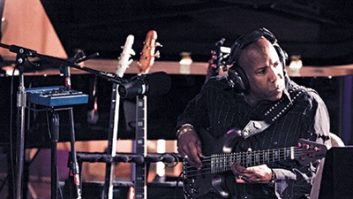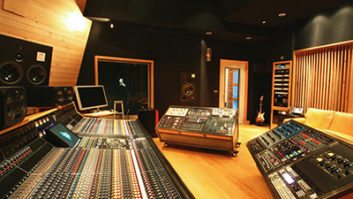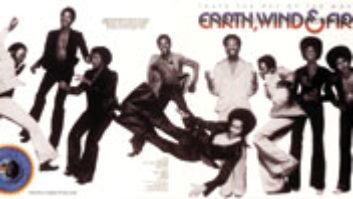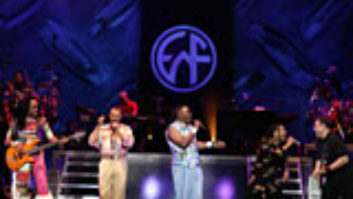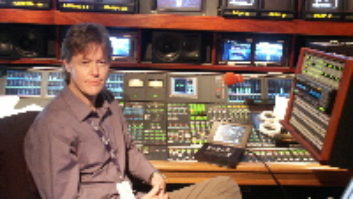For 31 years, Philip Bailey’s soaring falsetto has been one of the hallmarks of Earth, Wind & Fire’s dynamically charged R&B sound. Without question, his easily identifiable voice, along with the group’s dazzling and innovative instrumentation, are major factors in the group’s enduring success. Nonetheless, Bailey’s crystal-shattering vocal parts don’t display the full extent of his talents. He shines beautifully in the middle ranges as well, and even hits some low tones when necessary. But EWF fans rarely ever hear him sing extensively in those registers during shows or on recordings.
That could frustrate some singers, but Bailey says that he thoroughly understands his role, along with the group’s format and boundaries. In order to satisfy his wider creative urges, Bailey has undertaken an array of side projects through the years. One of them even became a Platinum-selling and Grammy-winning CD, China Wall, made with Genesis drummer/vocalist Phil Collins in 1984 and highlighted by the mega-hit “Easy Lover.”
Other solo endeavors for the EWF vocalist included gospel recordings and musically adventurous amalgamations such as the 1999 Head Up/Telarc album Dreams, which included numerous jazz luminaries, including Pat Metheney, keyboardist/vocalist George Duke, saxophonist Grover Washington Jr., saxophonist Kirk Whalum, trumpeter Randy Brecker, keyboardist Joe McBride, guitarist Peter White, bassist Gerald Veasley and others.
The title of Bailey’s latest Heads Up release, Soul on Jazz, describes the project perfectly. It finds the singer delving into soulful, R&B-inflected mainstream jazz, crooning in a cooler, much more relaxed mode than his piercing EWF style. Accentuating the engaging arrangements are such players as Bob Belden (percussion/soprano saxophone; he also produced several tracks), Myron McKinley (keyboards, production), Scott Kinsey (keyboards, production), Billy Kilson (drums), Ira Coleman (acoustic bass), Allan Burroughs (acoustic guitar), Don Alias (percussion), Mike “Dino” Campbell (guitar), and a number of other top-notch musicians and backing singers.
Although he isn’t normally associated with jazz, Bailey insists that he’s been interested in the genre since his years growing up in Denver. “I grew up listening to it as a kid and always loved it,” Bailey says from a hotel room in Las Vegas while touring with EWF. “But this is not the first jazz project I’ve worked on. In terms of singing and doing backgrounds, I’ve done records with Fourplay and The Pride of Lions with the late, great Tony Williams, Billy Childs on piano and Roy Hargrove on trumpet. That kind of whet my appetite to actually do a full-out jazz project.”
For this project, Bailey picked songs by such jazz greats as Joe Zawinul, Chick Corea, Herbie Hancock and Thelonious Monk, as well as the standard “Nature Boy,” and a new original written by Myron McKinley with lyrics by Bailey’s son (who also fashioned words for two other songs on the disc). There is also an intriguing reworking of the EWF hit “Head to the Sky, “which was done with regards to 9/11 and meant to be uplifting,” Bailey says.
Unlike EWF’s recordings, which can literally take years to complete, this album was cut in about a month — during October and November of 2001 — at Bennett Studios in Englewood, N.J. “The CD was really a testament to planning in terms of just knowing what we wanted to do,” Bailey says. “EWF has been working on a new record it seems like forever now, and I don’t know when we’re ever going to get it out.”
Much of the early work on the album was supervised by Bob Belden, who produced more than half of the tunes on Soul on Jazz. “Scott Kinsey and I did pre-production sketches on Digital Performer, and we e-mailed each other files and added stuff. Once Philip agreed on the tempo, form and other things, Scott recorded a lot of the parts into his laptop [G3 Powerbook]. Then, through my MOTU 828 [FireWire audio interface], we transferred the basic tracks, which were all done at home. So on the first day, we dumped all of the digital stuff in the computer to analog.
“On the second day, Myron worked on his things with the rhythm section [for live tracking with Bailey doing scratch vocals]. For the third day, I worked with Scott and the rhythm section for our tunes. Then, on the fourth and fifth day, we did overdubs with live horns. Plus, we had a second studio running at the same time for vocal overdubs. The whole thing was to keep everything running, and Philip just went from one room to the other.”
Engineer Robert Friedrich concurs with the producer in regards to the efficient use of studio time. “It was quite intense, and we pretty much wrapped up the record in three or four weeks, from top to bottom,” he says. “That was unique for a project of that magnitude. Originally, it was going to be just a jazz band backing up Philip [recorded analog], and then it kind of evolved into an R&B record with 48 tracks of analog and Pro Tools. We got involved with background vocals and other overdubs, and it kind of snowballed. While I was recording in one room, we were making stripes onto Pro Tools and doing submixes in the alternate one.” Most of the tracks for the Soul on Jazz sessions were recorded on a pair of 24-track 2-inch Studer decks. Supplemental overdubs and backing vocals were recorded direct to Pro Tools.
Like all current Telarc/Heads Up CDs, this one was mixed in both stereo and surround, notes engineer Friedrich, who’s also a classically trained violinist. “Basically, after I get my stereo mix going, we check out what we’re going to do with surround. There’s no real formula or anything, and the Genex recorder [used for the surround mix] has eight channels. We often do two channels stereo and six surround. In the case of Philip’s record, we did two separate mixes. For example, the stereo one had one trumpet echoing and comping Philip. On the surround, we had a different trumpet coming from the back and comping the front trumpet. That was Bob Belden’s idea.”
Mixing for the project took about five days at O’ Henry in Los Angeles in mid-December 2001. The facility has a SSL 9000 J board and is a favorite of the Telarc/Heads Up staff. Friedrich and executive producer (and percussionist) Dave Love were the primary mixers, though they had plenty of input from McKinley, Belden and Kinsey. “I told [Friedrich] on certain tracks to keep it dry,” states Belden in regards to his mixing preferences. “More like a club or contemporary R&B sound, instead of being drenched in reverb like most jazz recordings are. On ‘Nature Boy,’ we wanted it to be kind of atmospheric, but not for the rest of the stuff.”
Friedrich notes that mixing 2-inch analog and Pro Tools sessions simultaneously “was bumpy at first, but once we got everything going, it was smooth sailing. But they were long hours — some days we were there for 20 hours. [In some cases], we mixed more than 60 tracks of music, with a lot of processing. Normally, I don’t want that kind of compression. But it was a really difficult record to mix, mainly because it combined such different worlds — drum machines, synth processors with acoustic instruments. How do you blend all of these? Mostly, it was a balance issue. Also, we used a good amount of effects, such as plates and delays.”
Still, Friedrich believes that some of the album’s magic derives from this combination of seemingly disparate styles, elements and ways of working. “I think we all really fed off of each other,” he says. “Bob [Belden] let me take care of what I needed to take care of. He and Philip had a very good relationship, and everything was done very calmly and systematically. Dave Love had a big role, also; he was there throughout and organized what had to be done in the various rooms. Bob [and McKinley and Kinsey] would handle the musicians, Philip would discuss directions and I would record. No one ever butted heads once, it was a real great team effort, and everyone had a musical input into this record.”
Belden says that they never lost sight of the ultimate goal: “All we wanted to do was make an album that promoted the idea of jazz, which brought it closer to people. It should attract listeners that like soulful music.”

